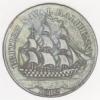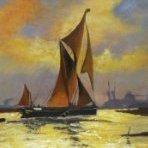MORE HANDBOOKS ARE ON THEIR WAY! We will let you know when they get here.
×
-
Posts
1,027 -
Joined
-
Last visited
Reputation Activity
-
 alde got a reaction from FrankWouts in HMS Sphinx 1775 by Ronald-V - Vanguard Models - 1:64
alde got a reaction from FrankWouts in HMS Sphinx 1775 by Ronald-V - Vanguard Models - 1:64
Ronald, your planking is absolutely beautiful. I have been enjoying your build log and have been learning quite a lot. Thank you for explaining everything.
-
 alde reacted to Burgundy in US Brig Syren by Redshadowrider - Model Shipways - Scale 1:64 - First wooden ship build
alde reacted to Burgundy in US Brig Syren by Redshadowrider - Model Shipways - Scale 1:64 - First wooden ship build
Hey @Redshadowrider, pulling up a chair! Starting my own Syren soon (actually restarting, I had an early snafu with the filler blocks and nuked the spine trying to fix with power tools, big no-no). Love the ingenuity so far, and all the custom tools you've made along the way. Definitely stealing the idea to build the port templates early on! Will be following the rest of your build.
-
 alde got a reaction from AJohnson in HMS Sphinx 1775 by Ronald-V - Vanguard Models - 1:64
alde got a reaction from AJohnson in HMS Sphinx 1775 by Ronald-V - Vanguard Models - 1:64
Ronald, your planking is absolutely beautiful. I have been enjoying your build log and have been learning quite a lot. Thank you for explaining everything.
-
 alde reacted to mtbediz in USS Constitution by mtbediz - 1:76
alde reacted to mtbediz in USS Constitution by mtbediz - 1:76
The planks need to be bent to fit snugly into the bulkheads. Both lateral and edge bending is required in the bow.
By the way, the end of the road is in sight in planking.
-

-
 alde reacted to mtbediz in USS Constitution by mtbediz - 1:76
alde reacted to mtbediz in USS Constitution by mtbediz - 1:76
Hull planking continues. Since each plank is prepared separately and glued into place with PVA, the progress is a little slow.
-
 alde reacted to mtbediz in USS Constitution by mtbediz - 1:76
alde reacted to mtbediz in USS Constitution by mtbediz - 1:76
I have started preparing the wales and gluing them in place. I make the wales using 2x5 mm basswood planks. The planks are tapered a little at the bow and stern, and then, after being kept in boiling water for about 10 minutes, they are fastened in place with clamps and pins. After drying and taking shape, the planks are glued into place.
-
 alde reacted to mtbediz in USS Constitution by mtbediz - 1:76
alde reacted to mtbediz in USS Constitution by mtbediz - 1:76
I glued the filler blocks to the bow and stern then I started the hull planking..First, I put the garboards on both sides and then added another plank next to them. From now on, I will continue the planking from the top towards the keel.
-
 alde reacted to mtbediz in USS Constitution by mtbediz - 1:76
alde reacted to mtbediz in USS Constitution by mtbediz - 1:76
After completing the planking of the spar deck gunports, I plan to start planking the hull.
-

-
 alde reacted to mtbediz in USS Constitution by mtbediz - 1:76
alde reacted to mtbediz in USS Constitution by mtbediz - 1:76
I've started planking the upper hull. First, I am making between the gun ports. To guide me in aligning the planks, I temporarily clamped a plank running from bow to stern.
-
 alde reacted to mtbediz in USS Constitution by mtbediz - 1:76
alde reacted to mtbediz in USS Constitution by mtbediz - 1:76
Gun deck planking has been completed. I will do the outer planking of the upper hull. Meanwhile, the frames of the spar deck gun ports will also be made.
-
 alde reacted to mtbediz in USS Constitution by mtbediz - 1:76
alde reacted to mtbediz in USS Constitution by mtbediz - 1:76
I’ve started planking the gun deck. I am using 1x3 mm hornbeam strips and PVA glue.
-
 alde reacted to mtbediz in USS Constitution by mtbediz - 1:76
alde reacted to mtbediz in USS Constitution by mtbediz - 1:76
The gun deck hatches and ladders have been installed, I think it is time to install the gun deck planking now.
-
 alde reacted to mtbediz in USS Constitution by mtbediz - 1:76
alde reacted to mtbediz in USS Constitution by mtbediz - 1:76
In my previous post, I mentioned that I made the gratings in a different way. This method gave both easier and more satisfying results.
Of course, I am not the inventor of this method. I also saw it in another modeler's build log and I am sharing it here for my friends who do not know about this method. There is only one tip. The depth of the slots in the South-North direction and the depth of the slots in the East-West direction should be different so that a depth can be achieved.
-
 alde reacted to mtbediz in USS Constitution by mtbediz - 1:76
alde reacted to mtbediz in USS Constitution by mtbediz - 1:76
Prepare the tackle outside as shown in the photo and tighten it with a pair of tweezers after attaching it in place. This will make it much easier.
-
 alde reacted to mtbediz in USS Constitution by mtbediz - 1:76
alde reacted to mtbediz in USS Constitution by mtbediz - 1:76
I started mounting the chain plates to the fore channel.
-
 alde reacted to mtbediz in USS Constitution by mtbediz - 1:76
alde reacted to mtbediz in USS Constitution by mtbediz - 1:76
The chain plates and deadeyes have been mounted to the main channel on the starboard side.
-
 alde reacted to Der Alte Rentner in USS Constitution by Der Alte Rentner - Model Shipways - 1/76
alde reacted to Der Alte Rentner in USS Constitution by Der Alte Rentner - Model Shipways - 1/76
Since I ready faked the sheaves, not just on the stanchions, but also the ridding bitts,
I'm in no immediate rush for round cutters less than a millimeter in diameter. That doesn't mean I'm not going to shop for them, while I'm looking for something that'll cut a square hole 2 mm across for the wooden post that passes through the top of the ridding bites. (Hunt uses round brass stock, which I may resort to if I can't fit a square piece.) Mustafa, if you are reading this, how did you manage to get square posts into your ridding bitts?
For larger woodworking projects, I have a tool that's a combination chisel/drill. Great for cutting mortises. I doubt I'm going to find anything small enough to work here..
Since I posted this response to Woodartist, I've taken a different direction. See proof of concept below:
I plan to put a 1/32" inch thick brass cap on top of the ridding bitt to finish it off.
-
 alde reacted to Ronald-V in HMS Sphinx 1775 by Ronald-V - Vanguard Models - 1:64
alde reacted to Ronald-V in HMS Sphinx 1775 by Ronald-V - Vanguard Models - 1:64
Thanks for your kind words! 🙏
-
 alde got a reaction from Knocklouder in HMS Sphinx 1775 by Ronald-V - Vanguard Models - 1:64
alde got a reaction from Knocklouder in HMS Sphinx 1775 by Ronald-V - Vanguard Models - 1:64
Ronald, your planking is absolutely beautiful. I have been enjoying your build log and have been learning quite a lot. Thank you for explaining everything.
-
 alde got a reaction from Ronald-V in HMS Sphinx 1775 by Ronald-V - Vanguard Models - 1:64
alde got a reaction from Ronald-V in HMS Sphinx 1775 by Ronald-V - Vanguard Models - 1:64
Ronald, your planking is absolutely beautiful. I have been enjoying your build log and have been learning quite a lot. Thank you for explaining everything.
-
 alde reacted to James H in HMS Surprise 1796 (prototype) by James H - Vanguard Models - 1:64
alde reacted to James H in HMS Surprise 1796 (prototype) by James H - Vanguard Models - 1:64
And these photo will need no explanation. These were made while waiting for other things to set etc.
Until next time.
-
 alde reacted to James H in HMS Surprise 1796 (prototype) by James H - Vanguard Models - 1:64
alde reacted to James H in HMS Surprise 1796 (prototype) by James H - Vanguard Models - 1:64
Time for an update. I've been away for just over two weeks and since returning, I've fought bad weather (for outside MDF sanding) and my head being crushed (metaphorically) from my new job.
Ok, here we go.
As the basic hull framing is now complete, it's time to prep it for the flat stuff (bulwarks, planks etc.). For this, I used 120 grit aluminium oxide paper, wrapped over a bit of thin ply. The inner bulwarks are easy to sand flat, with no protrusions etc...just a levelling of the various elements of the frame.
Aware that the bulkhead ears are always going to be vulnerable in some modeller's hands, jigs have been supplied that you clip to the protruding ears. These are now clipped to each of those areas.
The hull is now faired. To do this, I used a combination of sanding paper, sanding sticks, and a sanding mouse. A strip of lime was used to gauge removal of material.
Before I do anything to the interior, I need to take the inner bow bulwarks and soak these so they can be clamped into the areas to retain their new shapes. These are left for 24hrs to return back to their pre-soak size. Pear does expand a LOT when soaked.
-
 alde reacted to Argaen Lok in US Brig Syren by Argaen Lok (aka Scott Larkins) - Model Shipways - Scale 1:64
alde reacted to Argaen Lok in US Brig Syren by Argaen Lok (aka Scott Larkins) - Model Shipways - Scale 1:64
Nope, no pre-stain. Just put it straight on. After I did some test stains on some scrap pieces first.






